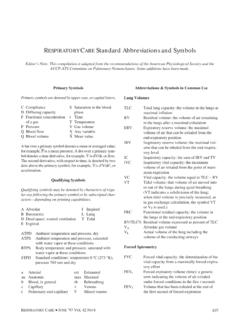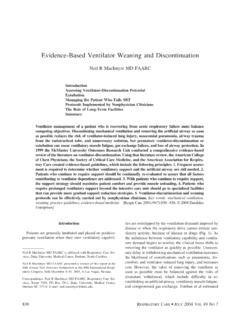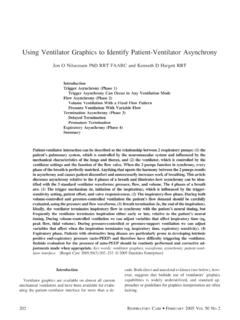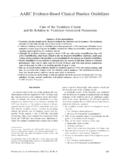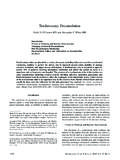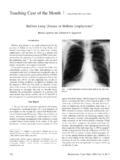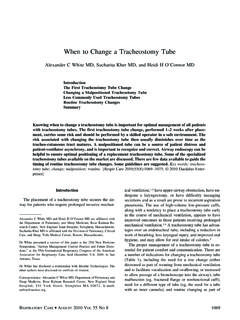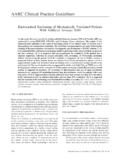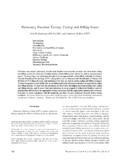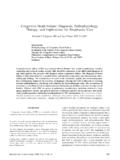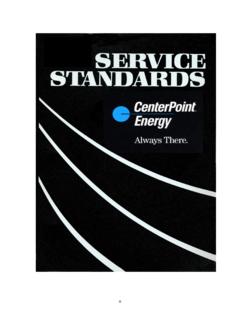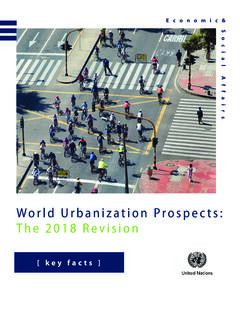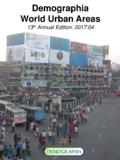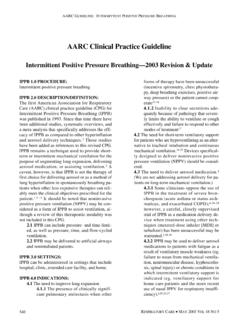Transcription of AARC Clinical Practice Guideline - Respiratory Care
1 AARC Guideline : bronchoscopy assisting . AARC Clinical Practice Guideline bronchoscopy assisting 2007 Revision & Update BA PROCEDURE properties of the upper airway1,2,4,6,8. The role of the assistant in bronchoscopy assisting The need to investigate hemoptysis, persis- (BA) tent unexplained cough, dyspnea, localized wheeze, or stridor1,2,4-8,10. BA DESCRIPTION/DEFINITION Suspicious or positive sputum cytology re- bronchoscopy , fiberoptic or rigid, is an invasive sults1,2,4-6. procedure for visualization of the upper and lower The need to obtain lower Respiratory tract Respiratory tract for the diagnosis and management secretions, cell washings, and biopsies for cyto- of a spectrum of inflammatory, infectious, and ma- logic, histologic, and microbiologic evalua- lignant diseases of the airway and ,2 Bron- tion1,2,4,7,9,11,12.
2 Choscopy may include retrieval of tissue specimens The need to determine the location and ex- (bronchial brush, forceps, and needle), cell wash- tent of injury from toxic inhalation or aspira- ings, bronchoalveolar lavage, coagulation, or re- tion1,2,4,6. moval of abnormal tissue by laser. bronchoscopy is The need to evaluate problems associated widely used as a diagnostic and therapeutic tool for with endotracheal or tracheostomy tubes (tra- management of the bronchoscopy is per- cheal damage, airway obstruction, or tube formed by a specially trained physician broncho- placement)1,2,4-7.
3 Scopist and is assisted by a specially trained health- The need for aid in performing difficult in- care professional (HCP). This Guideline addresses tubations or percutaneous tracheostomies1,2,4,6,7. the role of the HCP in bronchoscopy assistance The suspicion that secretions or mucus (BA)4 (Section ). plugs are responsible for lobar or segmental at- electasis1,2,4-6. BA SETTINGS The need to remove abnormal endo- The preferred location for bronchoscopy is deter- bronchial tissue or foreign material by forceps, mined by the available equipment, the medical con- basket, or laser1,2.
4 Dition and age of the patient, and the specific proce- The need to retrieve a foreign body (al- dures to be ,2,4 A designated bron- though under most circumstances, rigid bron- choscopy room or suite is the preferred location for choscopy is preferred)6,7,13. outpatients or inpatients who are not critically ill. Therapeutic management of endo- The procedure may be safely performed at the bed- bronchial toilet in ventilator associated pneu- side in the intensive care unit, the operating room, monia14. an appropriately equipped outpatient facility, or Achieving selective intubation of a main other suitably equipped Clinical ,2,4 stem bronchus14.
5 The need to place and/or assess airway BA INDICATIONS stent function14. Indications include but are not limited to The need for airway balloon dilatation in The presence of lesions of unknown etiolo- treatment of tracheobronchial stenosis15,16. gy on the chest radiograph film or the need to evaluate recurrent pneumonia, persistent at- BA CONTRAINDICATIONS. electasis or pulmonary infiltrates1,2,4-9 Flexible bronchoscopy should be performed only The need to assess patency or mechanical when the relative benefits outweigh the risks. 74 Respiratory CARE JANUARY 2007 VOL 52 NO 1.
6 AARC Guideline : bronchoscopy assisting . Absolute contraindications include The safety of bronchoscopic procedures in Absence of consent from the patient asthmatic patients is a concern, but the presence or his/her representative unless a medical of asthma does not preclude the use of these emergency exists and patient is not com- procedures11,18. petent to give permission1,2 Recent head injury patients susceptible to Absence of an experienced broncho- increased intracranial pressures19. scopist to perform or closely and directly Inability to sedate (including time con- supervise the procedure1,2,4 straints of oral ingestion of solids or liquids17.)
7 Lack of adequate facilities and per- sonnel to care for such emergencies such BA HAZARDS/COMPLICATIONS. as cardiopulmonary arrest, pneumotho- Adverse effects of medication used before rax, or bleeding1,2,4 and during the bronchoscopic procedure4,7,20,21. Inability to adequately oxygenate Hypoxemia4,22. the patient during the procedure1,2 Hypercarbia The danger of a serious complication from Bronchospasm23. bronchoscopy is especially high in patients Hypotension24. with the disorders listed, and these conditions Laryngospasm, bradycardia, or other vagal- are usually considered absolute contraindica- ly mediated phenomena4,7,20.
8 Tions unless the risk-benefit assessment war- Mechanical complications such as epis- rants the procedure1,2,4 taxis, pneumothorax, and hemoptysis7,20,23,25. Coagulopathy or bleeding diathesis Increased airway resistance4,26. that cannot be corrected1,2,4 Death27. Severe refractory hypoxemia1,2,4 Infection hazard for health-care workers Unstable hemodynamic status in- or other patients28-31 (see also Section 13). cluding dysrhythmias1,2,4 Cross-contamination of specimens or Relative contraindications (or conditions bronchoscopes28-31. involving increased risk), according to the Nausea, vomiting23.
9 American Thoracic Society Guidelines for Fever and chills23. Fiberoptic bronchoscopy in adults,1,2 include Cardiac dysrhythmias32. Lack of patient cooperation Recent (within 6 weeks) myocardial BA LIMITATIONS/VALIDATION OF RE- infarction or unstable angina17 SULTS. Partial tracheal obstruction bronchoscopy should not be performed in Moderate-to-severe hypoxemia or patients who have a contraindication listed in any degree of hypercarbia Section of this Guideline , unless the poten- Uremia and pulmonary hyperten- tial benefit outweighs the risk, as determined by sion (possible serious hemorrhage after the physician bronchoscopist.)
10 Biopsy) Poor or inadequate training of the bron- Lung abscess (danger of flooding choscopy assistant or bronchoscopist the airway with purulent material) The techniques of premedication for Obstruction of the superior vena bronchoscopic examination cava (possibility of bleeding and laryn- Function and preparation of bron- geal edema) choscope and related equipment Debility and malnutrition Physical and physiologic monitor- Disorders requiring laser therapy, ing during the procedure biopsy of lesions obstructing large airways, Specimen retrieval (biopsies and or multiple transbronchial lung biopsies washings), preparation of specimens, and Known or suspected pregnancy site documentation (safety concern of possible radiation ex- Post-procedure care of the patient posure).
